#33: The Girl On Page 44 by the Four Lads
City: Hull, QC
Radio Station: CKCH
Peak Month: March 1959
Peak Position in Hull ~ #1
Peak position in Vancouver ~ #30
Peak Position on Billboard Hot 100 ~ #52
YouTube: “The Girl On Page 44”
Lyrics: “The Girl On Page 44”
The Four Lads are a Canadian male quartet from Toronto, Ontario. They were originally made up of Corrado “Connie” Codarini, James F. “Jimmy” Arnold, John Bernard “Bernie” Toorish and Frank Busseri. They met as members of St. Michael’s Choir School. Originally, they named themselves the Otnorots (made up mostly of spelling the place name Toronto backwards. They changed their name to the Four Dukes. But after they found out a group in Detroit had the same name, then they settled on the Four Lads. They got a break when Mitch Miller noticed them when they were recruited by talent scouts to go to New York. Mitchell had them sing back-up on Johnny Ray’s 1951 smash hit, “Cry”, and his big follow up, “The Little White Cloud that Cried”.
In 1952 they had their first Top Twenty hit in the USA with “The Mocking Bird”. That same year “Faith that Can Move Mountains” climbed to #7 in the UK. The next year they had their first of eight Top Ten hit records in the USA with a novelty hit, Istanbul (Not Constantinople). Their biggest hits were the four million selling “Moments to Remember” and million selling “No Not Much”. A third million seller was “Standing on the Corner”. It was a song from the 1956 Broadway Musical The Most Happy Fella.
In early 1957 the Four Lads released had a Top Ten hit titled “Who Needs You”. This was followed by “I Just Don’t Know”. In Vancouver, the B-side to this single, “Golly”, also charted on CKWX. Between 1951 and 1958 the Four Lads had twenty-one Top 30 hits on the Billboard pop charts. Though their star was falling, Vancouver audiences landed the Four Lads ten charting singles between 1957 and the summer of 1960.
In 1959, the Four Lads released “The Girl On Page 44”.
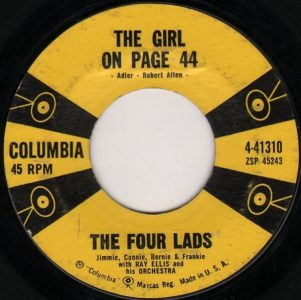
“The Girl On Page 44” is a song about a guy who’d like “to get a girl from Sears and Roebuck, like the one I saw wearing short shorts on page 44.” The “short shorts” phrase is in reference to the Top Ten hit by the Royal Teens, “Short Shorts“, from 1958. Young females who wore short shorts – very short cutoff jeans – in the late 50’s were “crazy chicks” that made many guys flip their lids. Previously, the guy in the song tells listeners he’s ordered “spark plugs and fancy ties” from the department store catalogue. But now he wants to order “the gal with baby blue eyes.” If only he could find the order number in the catalogue for this gal, he’d “spend a million kisses.” Feeling urgency, he wants “Mr. Sears and Mr. Roebuck” to send her to him by “Air Mail Special K-O-D.”
Domestic U.S. Air Mail was formally established as a new class of service by the Post Office Department on May 15, 1918, with the inauguration of the Washington–Philadelphia–New York route for which the first of special Air Mail stamps were issued.
Cash On Delivery or C.O.D. was established by the 1780s in America. C.O.D. puts the ball in the court of the consumer, who gets the ability to inspect the thing they’re accepting before paying for it, which means they can turn it down. That, of course, means that much of the risk gets placed onto the seller, who may have to cover the shipping and return costs as a result.
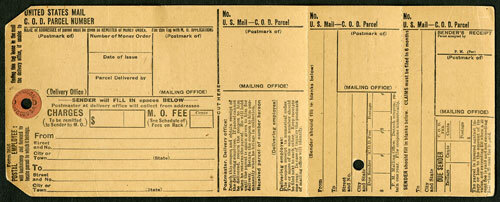
C.O.D. parcel slip (1917-1919) U.S. Postal Service
In “The Girl On Page 44” the customer wants Sears and Roebuck to honor deliver not by C.O.D. but by K.O.D. At the end of the song the Four Lads explain that K.O.D. stands for Kisses On Delivery.
Before there was Amazon.com, there was the Sears catalog. Founded as a mail-order watch company in 1886, Sears, Roebuck and Company made its name with its swollen, jam-packed catalogs that advertised everything from underwear to entire house kits. Around the holidays, families across the country would circle items in its legendary “Wish Book.”
Sears promoted their catalogue as the “Cheapest Supply House on Earth” or “the Book of Bargains.” It featured a mind-boggling array of products, including medical and veterinary supplies, musical instruments, firearms, bicycles, sewing machines and baby buggies. By 1894, the page count of the catalog was 322 pages. Richard Sears, who wrote almost all of the catalog’s copy himself until his retirement in 1908, held to the motto “We Can’t Afford to Lose a Customer.”
Sears Roebuck house kits to make a complete house. In 1908, there were 447 different house designs from the opulent Magnolia for $5,972, to the modest Winona starting at $774.
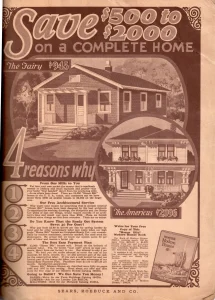
In the 1920s, the Sears Roebuck Catalogue featured The Americus model house for $2,096. From 1908 to 1940, Sears sold between 70,000 to 75,000 homes.
With the rise of the automobile after WWI, the mail-order boom in the United States slowed down. But Sears managed to stay successful by expanding consumer credit with its “No Money Down” policy and, in 1924, opening its first retail store in Chicago. More than 300 Sears stores would open across America by 1929. By 1931 retail sales outstripped catalogue sales.
By the 1950s, Sears had over 700 stores in the USA, plus more stores in Canada and Mexico. In Canada, Sears joined with Simpsons to become Simpson-Sears.
A section in each Sears Roebuck catalogue included women’s fashions.
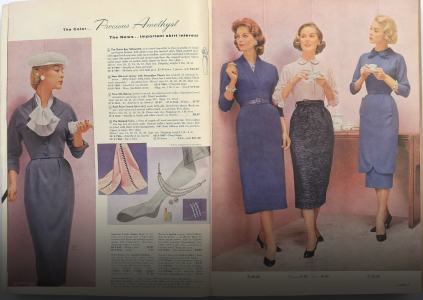
In 1951 Jane Russell wore a pair of shorts that was quite risqué. Perhaps this was the type of short the guy in “The Girl On Page 44” sees in the Sears Roebuck catalogue.
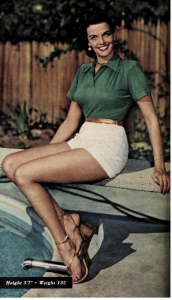
Most of the women wearing pants in the Sears Roebuck catalogue in the 1950s wore capris – three quarter length pants, or some other “shorter” pant that still covered the knees.
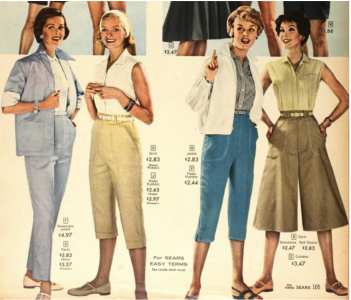
1959 Sears catalogue capris, pedal pushers and culottes pants
Sears was the top retail seller until 1991 when Wall-Mart eclipsed it in sales. Sears catalogue division closed in 1993 and Sears went online in 1999. Sears went bankrupt in 2018.
“The Girl On Page 44” was co-written by Richard Adler and Robert Allen. Robert Allen Deitcher was born in 1927 in Troy (NY). He was raised in a Jewish family. He was an accompanist for Perry Como, vaudevillian Peter Lind Hays and Arthur Godfrey. In 1952, his song “To Know You (Is to Love You)” was a Top 20 hit for Perry Como. In 1953, “My One and Only Heart” was a #11 pop hit for Perry Como, while “You Alone (Solo Tu)” reached #9. And in 1954, Como recorded the seasonal favorite, “(There’s No Place Like) Home for the Holidays”, which eventually peaked at #8 on the Billboard Hot 100 in January 1955 on the Billboard Most Played by Jockeys chart.
In 1955, Robert Allen wrote “Moments To Remember” which was a #2 hit on the Billboard pop chart and #17 for the year. In 1956, “No Not Much” for the Four Lads peaked at #2 on the Billboard Disc Jockey chart. That year “Song for a Summer Night” for Mitch Miller reached #8 on the Billboard pop chart. While in 1957, Allen had another hit for the Four Lads titled “Who Needs You?” which peaked at #9. He also had Top Ten hits that year for Johnny Mathis with “Chances Are” and “It’s Not For Me To Say”. In 1958, Allen co-wrote “There’s Only One Of You”. It reached #10 on the Billboard Pop chart. While a song recorded by Pat Boone titled “If Dreams Came True” climbed to #7 on the Billboard pop chart. And “Everybody Loves A Lover” was a #6 hit in 1958 for Doris Day.
Richard Adler was born in New York City in 1921. His father was a Jewish concert pianist. Adler served in the U.S. Naval Reserve during WWII. From 1948 to 1956, Adler wrote the music for the popular ABC-radio and ABC-TV game show Stop the Music. He co-wrote “Rags To Riches” for Tony Bennett (1951), “Hey There” for Rosemary Clooney (1954), “Hernando’s Hideaway” for Archie Bleyer (1954), and “Steam Heat” for Patti Page (1954). He won a Tony Award in 1955 for Best Musical with The Pajama Game, which featured the songs “Hey There”, “Steam Heat” and “Hernando’s Hideaway”. In 1956, Adler won another Tony Award for Best Musical with Damn Yankees. It featured the songs “Whatever Lola Wants”, and “Heart”. Sarah Vaughan had a #6 hit with “Whatever Lola Wants” in 1955, while Eddie Fisher had a #6 hit that year with “Heart”. In 1953-54, he wrote the music for the musical revue John Murray Anderson’s Almanac which featured Harry Belafonte, Tina Louise, Polly Bergen, and Hermione Gingold. In 1962, Adler received a Tony Award nomination for Best Composer for the Broadway musical Kwamina.
“The Girl On Page 44” peaked at #1 in Hull (QC), #3 in Los Angeles, #4 in Boston, #5 in Salt Lake City, and #7 in Milwaukee.
With the onslaught of rock n’ roll The Four Lads traditional style of pop music was overcome by new male vocal groups like The Crests (“Sixteen Candles”), The Platters (“Twilight Time”), The Coasters (“Yakety Yak”), The Drifters (“There Goes My Baby”), The Flamingos (“I Only Have Eyes For You”), Dion and The Belmonts (“A Teenager in Love”) and The Kingston Trio (“Tom Dooley”).
However, the Four Lads still had staying power with their smash Top Ten hits from the 1950’s. In 1960 they were interviewed by Houston DJ, Paul Berlin at KNUZ. In answer to a question in Billboard magazine, “What type of recording artists makes the most effective guest for an on-air interview?” As reported on January 16, 1961, Paul Berlin said “My most interesting interview was with the Four Lads. Usually interviewing a group is most difficult, but these guys came equipped with musical jingles that they used most effectively… During our interview I had a Sears commercial. They took the spot and sang it, and you can’t imagine how effective it was, not only from the station’s standpoint but from the sponsor’s as well. Give a jockey a “showman” and you’ll get a good interview.”
Connie Codarini left the Four Lads in 1962. From the early 1980’s, in Medina, Ohio, Connie Codarini owned a restaurant called Penny’s Poorhouse, named after his wife. When Connie and Penny first came to Medina they were showing Great Danes. He kept Penny’s Poorhouse until 2007. Cashbox Magazine Canada reports that “Codarini was well known in the area for being an authentic bartender by making drinks from scratch and not taking short cuts.” Connie Codarini died in 2010.
John Bernard Toorish left the Four Lads in 1970. However, seventeen years later, in 1987, he reformed the Four Lads. Since the early 1970’s Toorish became an insurance underwriter with Equitable Insurance whose headquarters are in Manhattan’s financial district at 120 Broadway. As of 1992, Toorish was still working for Equitable Insurance, and doing some gigs with the Four Lads. As of this post in September 2024, Toorish is the only remaining founding member of the Four Lads who is still alive.
James Arnold left the Four Lads in the 1981, he founded the James Arnold School of Voice. Living in Sacramento, California, he taught voice lessons from his living room from the mid-80’s until his death. Arnold’s tenor was a key part of the Four Lads sound and helped them get Top Ten hits. James Arnold also led a children’s choir for seventeen years. He also was called upon to sing the American national anthem for the Sacramento Kings home games. He died at the age of 72 of lung cancer in 2004.
With a changing lineup, the Four Lads have continued to perform in concert for 65 years with concert dates as recently as 2015, including Frank Busseri as an original member. In 1984, the New York Times ran a story with the headline: Swinging With The Big Band Sound. At the time Frank Busseri was managing one of the incarnations of the Four Lads. Busseri also had recently produced an album showcasing the vocals of his love interest of six years, Lynn Roberts, titled Harry, You Made Me Love You. Busseri had ceased to be in the Four Lads lineup in 1978, choosing to manage them. Decades later he rejoined the lineup. One of the last concerts by the Four Lads was in Palm Springs on March 28, 2017, at the McCallum Theatre. Frank Busseri died in 2019 at the age of 86.
September 9, 2024
Ray McGinnis
References:
“James Arnold, 72, Singer in the Four Lads,” New York Times, July 5, 2004.
“The Four Lads Inducted 1984,” Canadian Music Hall of Fame, 1984.
“Frank Busseri,” legacy.com. April 27, 2019.
“Connie Codarini,” legacy.com, April 28, 2010.
Paul Berlin – KNUZ-AM in Houston, Programming Panel, Billboard, January 16, 1961.
“‘Four Lads’ Ladle out Hits to Fans at Swingos’ Eatery,” Lakewood Sun Post, August 6, 1992.
“Proudly Canadian: The Four Lads,” Cashbox Magazine Canada
Alvin Klein, “Swinging With The Big Band Sound,” New York Times, January 29, 1984.
“Robert Allen, 73, Whose Songs Were Sung by an Array of Stars,” New York Times, October 5, 2000.
Robert Simonson, “Near to You”: Composer Richard Adler Celebrated at Memorial,” Playbill, June 28, 2012.
“The Payment Comes After,” tedium.com.
“When the Sears Catalog Sold Everything from Houses to Hubcaps,” history.com.
Royal Teens, “Short Shorts“, ABC-Paramount Records, 1958.

CKCH 970-AM Hull (QC) Top Ten | March 7, 1959

Great write up on the Otnorots. I have not heard this song in years.
You’re welcome Tom. My parents used to have catalogues come in the mail like the ones the Four Lads sing about in this song. Even Sears.
Ray